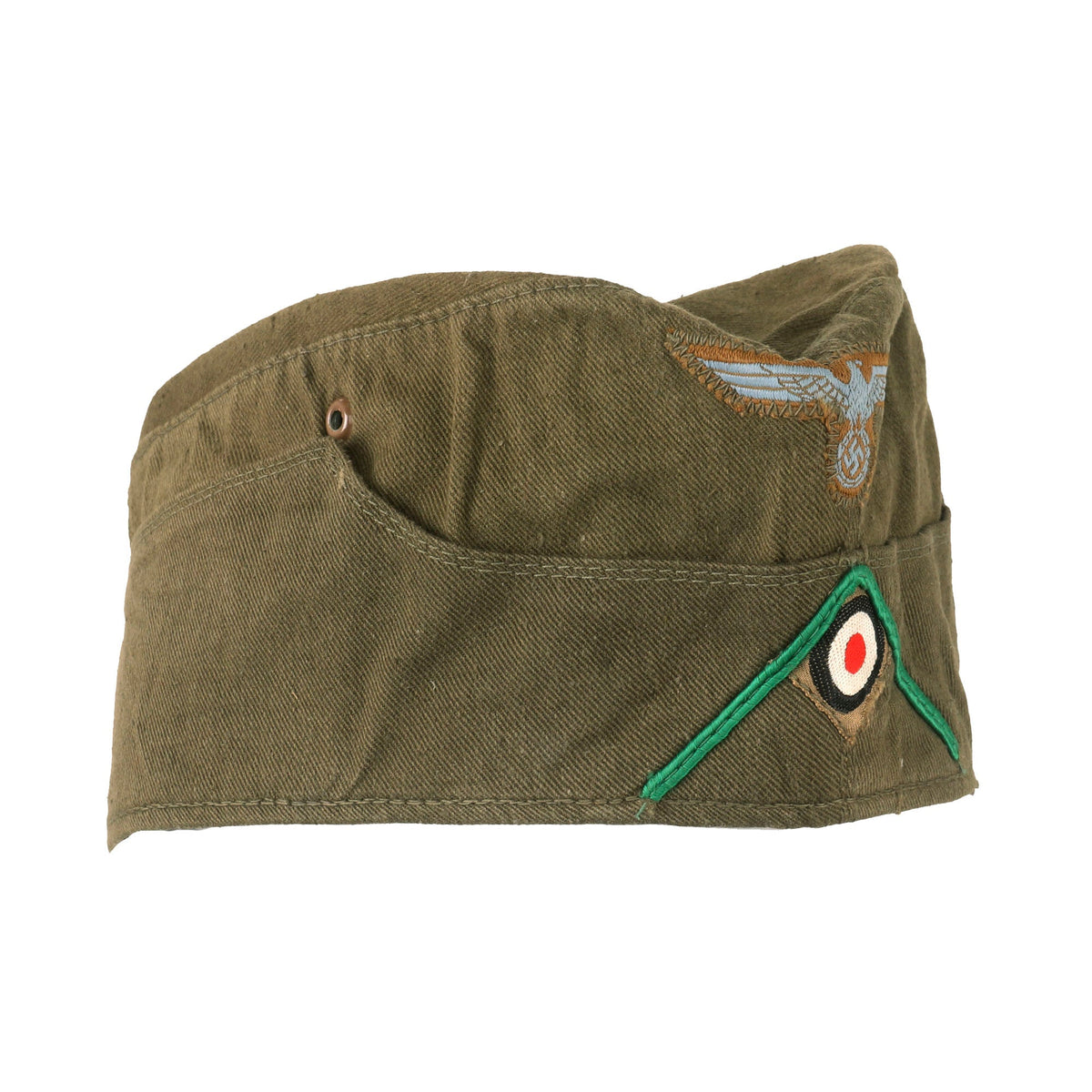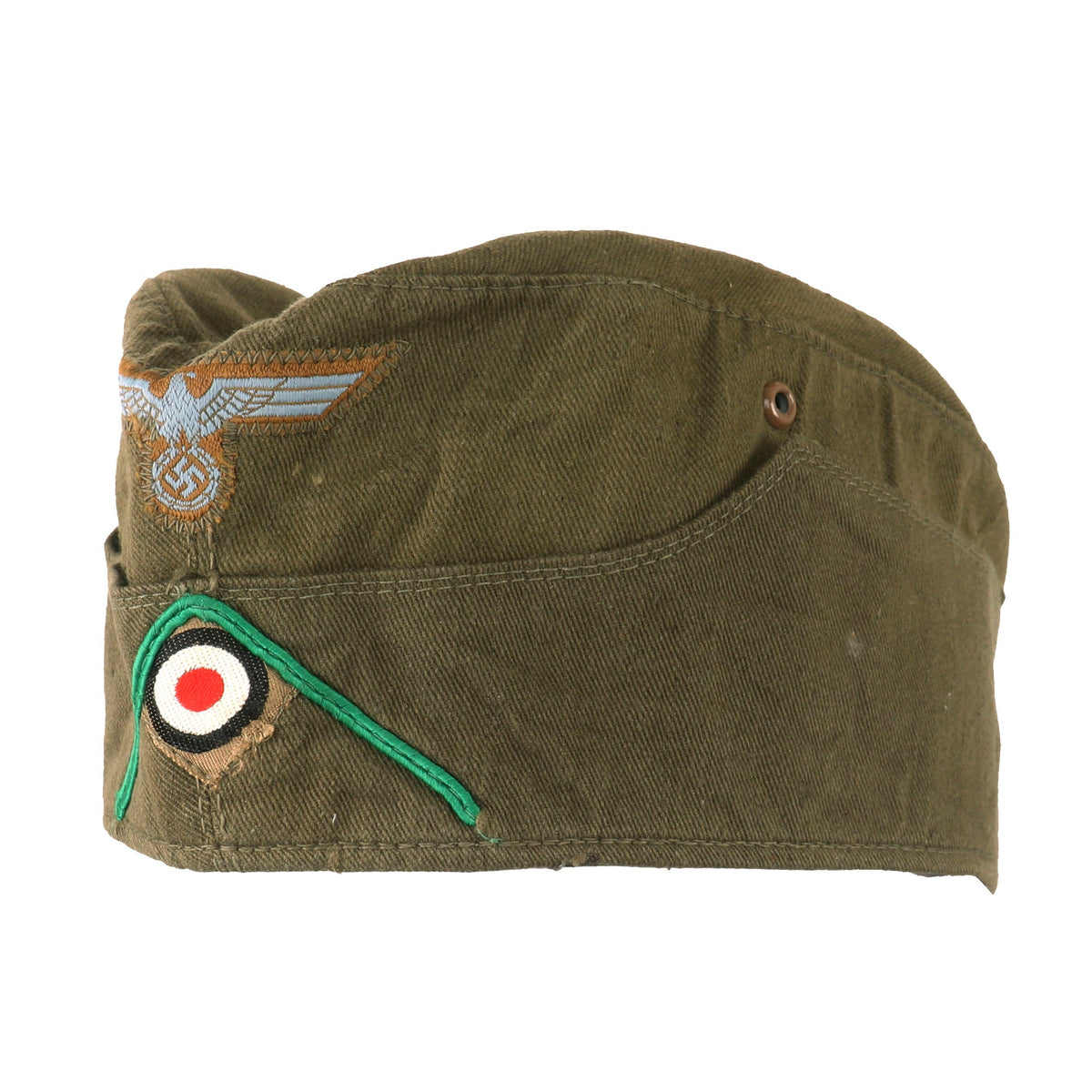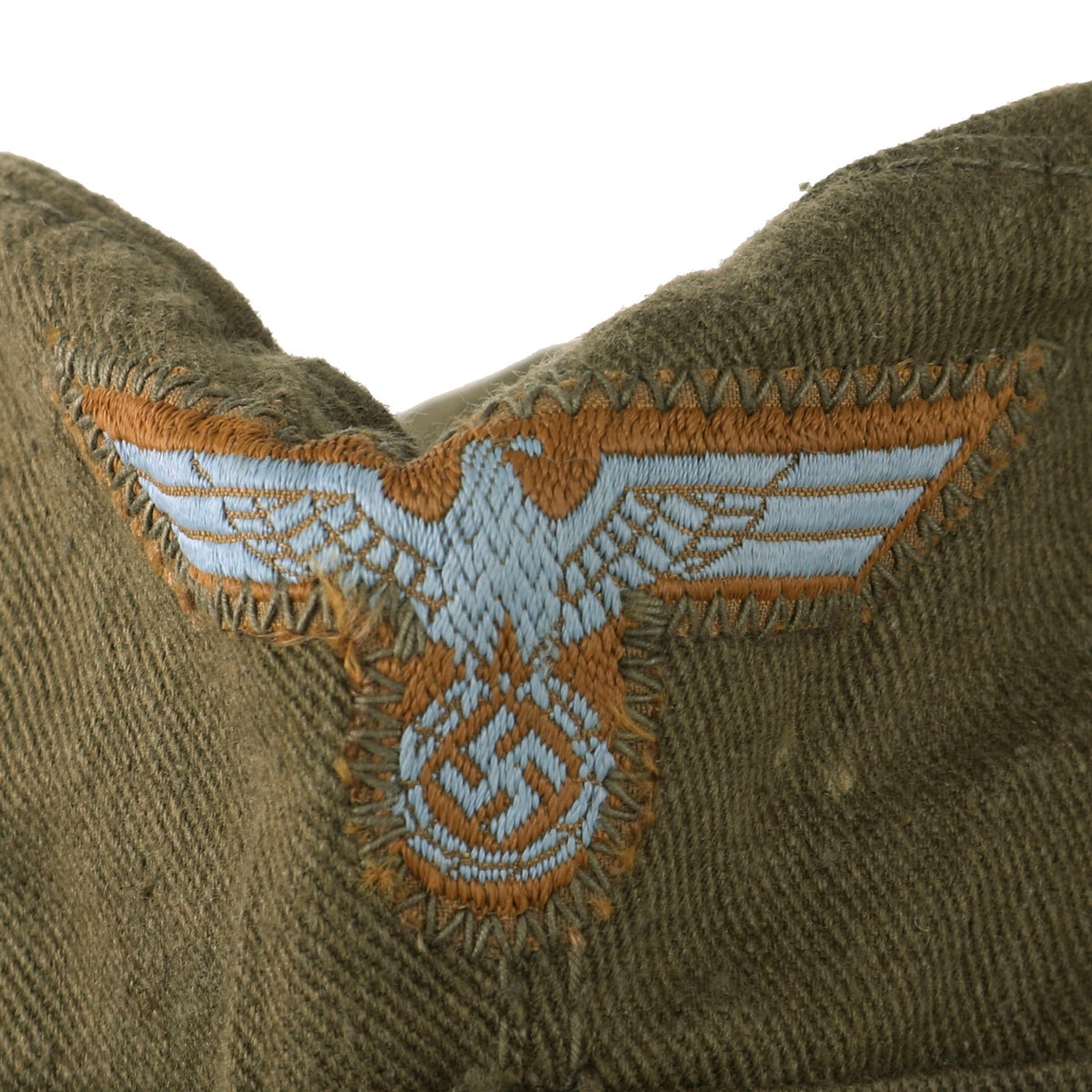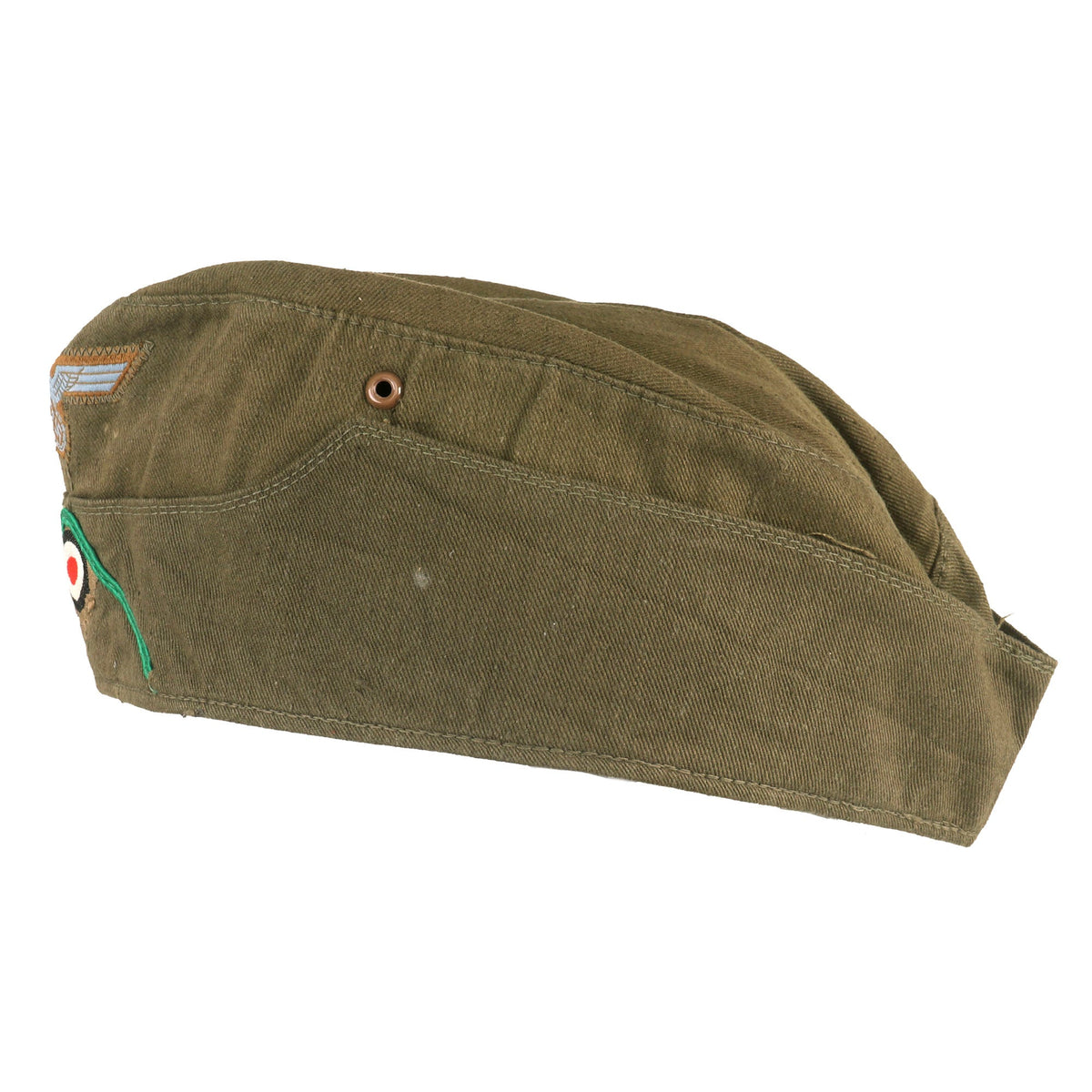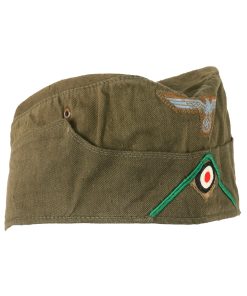Original German WWII 1942 Dated DAK Afrikakorps Gebirgsjäger EM-NCO M38 Overseas Cap by F. Weissbach – size 61cm Original Items
$ 895,00 $ 223,75
Original Item: Only One Available. The second most predominant item of Heer tropical soft headgear was based on the M-34 / 38 overseas cap, nicknamed in German army slang as Schiffchen, or literally “little ship” as it resembled an up-turned row-boat. It lacked a peak or visor, and was made in the same cotton as the M-40 ‘Afrikamütze’ cap. The production of these also started in 1940. The schiffchen utilized the same brown enameled stock for the vent holes as the M-40.
As with the continental wool version, the tropical overseas cap had turn-down sides, but these could not be folded down to cover the ears for cold weather protection because they were stitched in the front and back. Later war versions retained the seam, but were entirely sewn down, now just a separate part of the exterior.
The cap was also lined with red cotton, the sides being the last to be sewn in place. The insignia was sewn to the shell before the lining was added, and used exactly the same eagle, roundel and soutache as the M-40 ‘Afrikamütze’. From 1943 onwards, as with the M-40 billed cap, the eagle can be seen to be sewn on some examples on a triangular backing. This was a simple measure to speed up production, although it tended to lend the cap with a less attractive appearance.
The overseas cap was popular with armored vehicle crews due to the lack of a visor, which would get in the way of using optical equipment and continual banging against the sides, equipment, hatches and other obstructions in closely confined work spaces like tanks and armored vehicles. Due to their very utilitarian and somewhat unflattering appearance, the overseas cap never gained the affection that the M-40 evoked from those who wore them. These M-34 / 38 Pattern Tropical caps also have an important place in any tropical uniform collection.
This is a fantastic extra large size tropical pattern overseas cap, as worn by NCO and enlisted ranks in the DAK and southern Europe. Styled after the 1940 pattern, it is produced in olive-brown cotton twill with decorative scalloped “faux” flaps and tan enameled alloy vent grommets. The front has a very nice BeVO style machine embroidered light blue gray on Tan tropical pattern Heer eagle with the correct rayon BeVo tri-color Kokarde underneath. There is a very nice Hellgrün (Light Green) V-shaped soutache, which is the Corps Color (Waffenfarbe) for Gebirgsjäger (mountain troops ), Skijäger (ski troops), and Jäger (light infantry troops). The bottom stitches go over the soutache, so it was added to the cap during manufacture. It is machine sewn on with green thread on the front and olive thread on the rear, also period correct.
The interior has a liner of lightweight red cotton cloth that is faintly marked with full manufacturer and size information on the upper rear:
61
F. Weissbach
Glauchau
E 42
This is a VERY large size cap, and the bottom line indicates it was processed through the Erfurt clothing depot in 1942.It shows only very minor wear, mostly on the delicate insignia, with very little staining or fading. Both grommets are secure, and there are no structural fabric issues. This is a cap that would be VERY hard to improve upon.
A really great example of a hard to find cap, ready to display!
Gebirgsjäger material is among the most popular of all German WWII items. They were the light infantry part of the alpine or mountain troops (Gebirgstruppe) of Germany and Austria. The word Jäger (meaning “hunter” or “huntsman”) is a characteristic term used for light-infantry or light-infantryman in German-speaking military context.
The mountain infantry of Austria have their roots in the three Landesschützen regiments of the Austro-Hungarian Empire. The mountain infantry of Germany carry on certain traditions of the Alpenkorps (Alpine corps) of World War I. Both countries’ mountain infantry share the Edelweiß insignia. It was established in 1907 as a symbol of the Austro-Hungarian Landesschützen regiments by Emperor Franz Joseph I. These troops wore their edelweiss on the collar of their uniforms. When the Alpenkorps came to aid the Landesschützen in defending Austria-Hungary’s southern frontier against the Italian attack in May 1915, the grateful Landesschützen honored the men of the Alpenkorps by awarding them their own insignia: the edelweiss. Together with the Fallschirmjäger (Paratroopers) they are perceived as the elite infantry units of the German Army.
German Jäger Units –
Jäger (hunter) is a German military term referring to specific light infantry units. In German-speaking states during the early modern era, the term Jäger came to denote light infantrymen whose civilian occupations (mostly hunters and foresters) made them well-suited to patrolling and skirmishing, on an individual and independent basis, rather than as part of a large-scale military unit or traditional line infantry. As a consequence, Jäger was used to describe skirmishers, scouts, sharpshooters and runners.
The German Empire had various different Jäger units, which were disbanded at the conclusion of WWI. The Reichswehr of Weimar Germany did keep their traditions somewhat intact, and during the NSDAP led rearmament preceding WWII, various different Jäger units were reformed, the most famous of which were the Heer Gebirgsjäger Mountain Troopers and Luftwaffe Fallschirmjäger paratroopers. Later in the war, Skijäger Ski Troopers and Jäger Infantry units were raised, as well as some smaller units with more specific purposes, such as “Tank Hunters”.
Fast Shipping with Professional Packaging
Thanks to our longstanding association with UPS FedEx DHL, and other major international carriers, we are able to provide a range of shipping options. Our warehouse staff is expertly trained and will wrap your products according to our exact and precise specifications. Prior to shipping, your goods will be thoroughly examined and securely secured. We ship to thousands clients each day across multiple countries. This shows how we're dedicated to be the largest retailer on the internet. Warehouses and distribution centres can be located throughout Europe as well as the USA.
Note: Orders with more than one item will be assigned a processing date depending on the item.
Before shipping before shipping, we'll conduct a thorough inspection of the items you have ordered. Today, the majority of orders will be delivered within 48 hours. The delivery time will be between 3-7 days.
Returns
The stock is dynamic and we cannot completely manage it because multiple stakeholders are involved, including our factory and warehouse. So the actual stock may alter at any time. It's possible that you may not receive your order once the order has been made.
Our policy is valid for a period of 30 days. If you don't receive the product within 30 days, we are not able to issue a refund or an exchange.
You can only return an item if it is unused and in the same state as the day you received it. You must have the item in its original packaging.
Related products
Uncategorized
Band of Brothers ORIGINAL GERMAN WWII Le. F.H. 18 10.5cm ARTILLERY PIECE Original Items
Uncategorized
Uncategorized
Uncategorized
Uncategorized
Uncategorized
Uncategorized
Uncategorized
Uncategorized
Uncategorized
Uncategorized
Uncategorized
Uncategorized
Uncategorized
Australian WWII Owen MK1 Machine Carbine SMG Custom Fabricated Replica with Sling Original Items
Uncategorized
Uncategorized
Uncategorized
Uncategorized
Uncategorized
